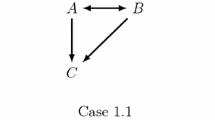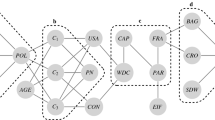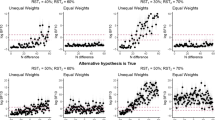Abstract
We address the oft-repeated criticism that the demands which the rational choice approach makes on the knowledge and cognition of a decision-maker (DM) are way beyond the capabilities of typical human intelligence. Our key finding is that it may be possible to arrive at this ideal of rationality by means of cognitively less demanding, heuristic-based ecological reasoning that draws on information about others’ choices in the DM’s environment. Formally, we propose a choice procedure under which, in any choice problem, the DM, first, uses this information to shortlist a set of alternatives. The DM does this shortlisting by a mental process of categorization, whereby she draws similarities with certain societal members—the ingroup—and distinctions from others—the outgroup—and considers those alternatives that are similar (dissimilar) to ingroup (outgroup) members’ choices. Then, she chooses from this shortlisted set by applying her preferences, which may be incomplete owing to limitations of knowledge. We show that, if a certain homophily condition connecting the DM’s preferences with her ingroup–outgroup categorization holds, then the procedure never leads the DM to making bad choices. If, in addition, a certain shortlisting consistency condition holds vis-a-vis non-comparable alternatives under the DM’s preferences, then the procedure results in rational choices.
Similar content being viewed by others
Notes
In this paper, we restrict attention to strict preferences and unique choices (choice functions). As such, when we say that preferences are complete, we mean that, for any two distinct alternatives, x and y, the DM either strictly prefers x to y or y to x.
In this paper, Aumann writes: “Of all the axioms of utility theory, the completeness axiom is perhaps the most questionable. Like others of the axioms, it is inaccurate as a description of real life; but unlike them, we find it hard to accept even from the normative viewpoint” (Aumann 1962, p.446).
In making this case, social psychologists have assembled an impressive body of evidence. For instance, the minimal group paradigm studies by Tajfel et al. (1971) clearly show that even the meaningless categorization of lab subjects on the basis of trivial and random criteria such as, for instance, the result of a coin-flip led to ingroup favoritism and discrimination against the outgroup. In many of these experiments, subjects were asked to anonymously divide a fixed sum of money between a member from their ingroup and one from their outgroup, who were, in turn, anonymous except for their group membership. In such settings, subjects chose to allocate as much as \(70\%\) of the money to the ingroup member. These findings have been replicated in several other settings, as well. In the context of the experimental economics literature, Chen and Li (2009), for instance, show that a randomly assigned group identity amplifies social preferences by inducing “ingroup altruism” and “outgroup envy”.
Another recent paper which develops the theme of social influence within a slightly different theoretical framework is Fershtman and Segal (2018).
We refer to a binary relation \(B \subseteq X\times X\) as (1) complete if for all \(x,y \in X\), \(x\ne y\), either xBy or yBx; (2) asymmetric if for all \(x,y \in X\), \([xBy]~\Rightarrow \)\(\lnot [y B x]\) and (3) transitive if for all \(x,y,z \in X\), \([xBy \wedge yBz]~\Rightarrow ~xBz\).
Specifically, \(x\succ _1y\succ _1z\), \(y\succ _2x\succ _2z\), \(z\succ _3y\succ _3x\), and \(z\succ _4y\succ _4x\).
For the index, we consider rankings that have a specific relationship with each other.
\(\succ ^*_S\) denotes the restriction of \(\succ ^*\) to S.
References
Aumann, R. J. (1962). Utility theory without the completeness axiom. Econometrica, 30, 445–462.
Chen, Y., & Li, S. X. (2009). Group identity and social preferences. The American Economic Review, 99, 431–457.
Cherepanov, V., Feddersen, T., & Sandroni, A. (2013). Rationalization. Theoretical Economics, 8, 775–800.
Cuhadaroglu, T. (2017). Choosing on influence. Theoretical Economics, 12, 477–492.
Fershtman, C., & Segal, U. (2018). Preferences and social influence. American Economic Journal: Microeconomics, 10, 124–142.
Gigerenzer, G., Todd, P. M., & ABC Research Group (1999). Simple Heuristics That Make Us Smart. Oxford: Oxford University Press.
Hornsey, M. J. (2008). Social identity theory and self-categorization theory: A historical review. Social and Personality Psychology Compass, 2, 204–222.
Lleras, J. S., Masatlioglu, Y., Nakajima, D., & Ozbay, E. Y. (2017). When more is less: limited consideration. Journal of Economic Theory, 170, 70–85.
Mandler, M., Manzini, P., & Mariotti, M. (2012). A million answers to twenty questions: choosing by checklist. Journal of Economic Theory, 147, 71–92.
Manzini, P., & Mariotti, M. (2007). Sequentially rationalizable choice. The American Economic Review, 97, 1824–1839.
Manzini, P., & Mariotti, M. (2012). Categorize then choose: boundedly rational choice and welfare. Journal of the European Economic Association, 10, 1141–1165.
Masatlioglu, Y., Nakajima, D., & Ozbay, E. Y. (2012). Revealed attention. American Economic Review, 102, 2183–2205.
Simon, H. A. (1955). A behavioral model of rational choice. The Quarterly Journal of Economics, 69, 99–118.
Simon, H. A. (1956). Rational choice and the structure of the environment. Psychological Review, 63, 129–138.
Tajfel, H., Billig, M. G., Bundy, R. P., & Flament, C. (1971). Social categorization and intergroup behaviour. European Journal of Social Psychology, 1, 149–178.
Todd, P. M., & Gigerenzer, G. (2012). Ecological rationality: Intelligence in the world. Oxford: Oxford University Press.
Turner, J. C. (1985). Social categorization and the self-concept: A social cognitive theory of group behavior. In E. J. Lawler & C. T. Greenwich (Eds.), Advances in Group Processes: Theory and Research (Vol. 2, pp. 77–122). Greenwich: JAI Press.
Tversky, A., & Kahneman, D. (1974). Judgment under uncertainty: Heuristics and biases. Science, 185, 1124–1131.
Author information
Authors and Affiliations
Corresponding author
Additional information
Publisher's Note
Springer Nature remains neutral with regard to jurisdictional claims in published maps and institutional affiliations.
We thank two referees for several constructive comments. Of course, any shortcomings in the paper are our responsibility.
A Appendix
A Appendix
1.1 Preliminaries
We first prove two lemmas that we use to prove our results.
Lemma A.1
If\((\succ ,\succ ')\)is an (xy)-TOP pair on\(S \in {\mathcal {P}}(X)\)with\(x \succ z\), for all\(z \in S{\setminus }\{x\}\), and\(\succ ^*\)is an asymmetric, transitive binary relation onSwith\(x \succ ^* y\), then
Proof
Since \((\succ ,\succ ')\) is an (xy)-TOP pair, \(w\succ z\) if and only if \(w\succ ' z\) for all \(w,z\in S{\setminus }\{x,y\}\). Hence:
and it follows that:
Define the sets \(S_1=\{z\in S: x\succ z \succ y\}\) and \(S_2=\{z\in S: y \succ z\}\). Clearly, \(S_1 \cup \ S_2 \cup \{x,y\} = S\). Furthermore, since \(x \succ z\), \(x \succ ' z\), \(y \succ z\) and \(y \succ ' z\), for all \(z \in S_2\), it follows that:
Therefore:
Next, define the sets
and verify that
-
\(|\succ -\succ ^*|_{\{x,y\}}-|\succ '-\succ ^*|_{\{x,y\}}=-1\)
-
\(\sum _{z\in S_1}\left[ |\succ -\succ ^*|_{\{x,z\}}-|\succ '-\succ ^*|_{\{x,z\}}\right] = \# V_1 - \# V_2\)
-
\(\sum _{z\in S_1}\left[ |\succ -\succ ^*|_{\{y,z\}}-|\succ '-\succ ^*|_{\{y,z\}}\right] = \# {\hat{V}}_2 - \# {\hat{V}}_1\).
Now, since \(\succ ^*\) is transitive and \(x \succ ^* y\), we have that \(z \succ ^* x \Rightarrow z \succ ^* y\). Hence, \(V_1 \subseteq {\hat{V}}_1\) and \(\# V_1 \le \#{\hat{V}}_1\). Furthermore, \(y \succ ^* z \Rightarrow x \succ ^* z\). Hence, \({\hat{V}}_2 \subseteq V_2\) and \(\#{\hat{V}}_2 \le \#V_2\). Accordingly, \([\# V_1 - \#{\hat{V}}_1] + [\#{\hat{V}}_2 - \#V_2] \le 0\) and, therefore:
Hence, \(|\succ -\succ ^*|_{S}-|\succ '-\succ ^*|_{S} < 0\).\(\square \)
Before stating the next lemma, we introduce some notation. For any choice problem \(S \in {\mathcal {P}}(X)\) and any alternative \(x\in S\) define the ecological support for x in this choice problem by the following:
That is:
Lemma A.2
Suppose that\(c_i\), \(i=1,\dots , n-1\), satisfies WARP, \(c_n\)is an ESH, and Homophily holds. If\(x \succ ^* y\), \(x, y \in X\), then for any\(S \in {\mathcal {P}}(X)\)with\(x, y \in S\), \(\gamma _S(x) \ge \gamma _S(y)\).
Proof
Let \(x, y \in S\) and \(x \succ ^* y\). First, note that if there exists no \(i \in {\mathcal {I}}\), such that \(c_i(S) = x\) or \(c_i(S) = y\), then \(\gamma _S(x)= \gamma _S(y)=0\) and our desired conclusion follows immediately. Therefore, consider the case where there exists \(i \in {\mathcal {I}}\) with \(c_i(S) = x\) or \(c_i(S) = y\). This means that there exists at least one (xy)-TOP pair, \(\succ \) and \(\succ '\), on S, such that \(\succ _{iS} = \succ \) or \(\succ _{iS}\)\(=~\succ '\). Furthermore, since \(x \succ ^* y\), from the last Lemma, we know that for any (xy)-TOP pair, \(\succ \) and \(\succ '\), on S with, say, x the top element of \(\succ \) and y of \(\succ '\), we have \(|\succ -\succ ^*_S|_S<|\succ '-\succ ^*_{S}|_S\). Therefore, under this case, the collection of relevant (xy)-TOP pairs on S is non-empty. Let \((\succ ^k, \succ '^k)_{k=1}^K\) be the set of all relevant (xy)-TOP pairs on S, where \(x\succ ^k z\) for all \(z \in S{\setminus } \{x\}\) and \(y \succ '^k z\), for all \(z \in S{\setminus } \{y\}\), for all \(k=1, \dots , K\). As such, the Homophily condition implies that \(\sigma ^S_{xy}\), the homophily index defined with respect to this collection of relevant (xy)-TOP pairs, is such that
That is:
That is:
Denote:
and we have that
That is:
That is:
Or, \(\gamma _S(x) \ge \gamma _S(y)\). \(\square \)
1.2 Proof of Propositions
1.2.1 Proof of Proposition 4.1
Consider \(x\in \Gamma (S)\) and \(y\in S{\setminus }\Gamma (S)\). That is, \(\gamma _S(x) > \gamma _S(y)\). Clearly, it cannot be the case that \(y \succ ^* x\), for then, by Lemma A.2, \(\gamma _S(y) \ge \gamma _S(x)\).
Let \(x^* \in S\) be such that \(x^* \succ ^* y\), for all \(y \in S{\setminus }\{x^*\}\). By Lemma A.2, \(\gamma _S(x^*) \ge \gamma _S(y)\), for all \(y \in S{\setminus }\{x^*\}\). Hence, \(x^* \in \Gamma (S)\) and \(c_n(S) = x^*\).
Let \(x \succ ^* y\). By Lemma A.2, \(\gamma _{\{x,y\}}(x) \ge \gamma _{\{x,y\}}(y)\). Therefore, either \(\Gamma (\{x,y\})=\{x,y\}\) or \(\Gamma (\{x,y\})=\{x\}\). In either case, \(c_n(\{x,y\})=x\), which implies \(x \succ _n y\). Hence, \(\succ ^*~\subseteq ~\succ _n\).
1.2.2 Proof of Proposition 4.2
Consider any sets \(S,T\in {\mathcal {P}}(X)\), such that \(c_n(S)=x\), \(y\in S\), \(x\in T\). To establish that \(c_n\) satisfies WARP, we need to show that \(c_n(T)\ne y\). If \(y \notin T\), the conclusion is immediate. Therefore, assume that \(y \in T\).
Our desired conclusion follows if we can show that \(c_n(S\cap T)=x\). We first show that \(x\in \Gamma (S\cap T)\). Clearly, \(\Gamma (S\cap T)\ne \emptyset \). Pick \(w \in \Gamma (S\cap T)\). If \(w=x\), we have reached the desired conclusion. Therefore, consider \(w\ne x\). First, note that it cannot be the case that \(w\succ ^* x\). Clearly, this cannot be the case if \(w \in \Gamma (S)\) since \(c_n(S)=x \succ ^* y\), for all \(y \in \Gamma (S){\setminus }\{x\}\). On the other hand, if \(w\in S{\setminus }\Gamma (S)\), then \(\gamma _S(x) > \gamma _S(w)\), by the definition of \(\Gamma (S)\). However, if \(w\succ ^* x\), then by Lemma A.2, \(\gamma _S(w)\ge \gamma _S(x)\)! Second, if \(x \succ ^* w\) then, by Lemma A.2, we have \(\gamma _{S\cap T}(x) \ge \gamma _{S\cap T}(w)\). Hence, \(x \in \Gamma (S\cap T)\). Finally, consider the case that neither \(x \succ ^* w\) nor \(w\succ ^* x\). In this case, first, it has to be that \(w\in S{\setminus }\Gamma (S)\) for if \(w \in \Gamma (S)\), then \(x\succ ^* w\). Second, \(\Gamma (\{x,w\})\ne \{x,w\}\) for if this were so, the ESH cannot determine what \(c_n(\{x,w\})\) is. Therefore, \(\Gamma (\{x,w\}) = \{x\}\) or \(\Gamma (\{x,w\}) = \{w\}\). However, \(\Gamma (\{x,w\}) \ne \{w\}\), since \(\Gamma (\{x,w\}) = \{w\}\), \(x\in \Gamma (S)\) and \(w\in S{\setminus }\Gamma (S)\) violates Ecological Shortlisting Consistency. Hence, \(\Gamma (\{x,w\}) = \{x\}\). Therefore, by the same condition, \(w \in \Gamma (S\cap T)\) implies that \(x \in \Gamma (S\cap T)\). That is, we have shown that \(x \in \Gamma (S\cap T)\) under all possible cases.
Finally, note that since \(c_n\) is an ESH, the set \(\Gamma (S\cap T)\) has a \(\succ ^*\)-maximal element. Arguments made above establish that this element has to be x and not some \(w\ne x\). To reiterate, if it was such a w, then clearly \(w\in S{\setminus }\Gamma (S)\), i.e., \(\gamma _S(x) > \gamma _S(w)\). However, \(w\succ ^* x\) would imply by Lemma A.2 that \(\gamma _S(w)\ge \gamma _S(x)\)! Hence, \(x \succ ^* y\), for all \(y \in \Gamma (S\cap T){\setminus }\{x\}\) and \(c_n(S\cap T)=x\).
We have already shown above in the proof of Proposition 4.1 that if Homophily holds, then \(\succ ^*\)\(\subseteq ~\succ _n\). Furthermore, it can be shown that if \(c_n\) satisfies WARP, then the base relation \(\succ _n\) is complete and transitive and, indeed, rationalizes \(c_n\). We omit those details here as they are quite standard.
Rights and permissions
About this article
Cite this article
Borah, A., Kops, C. Rational choices: an ecological approach. Theory Decis 86, 401–420 (2019). https://doi.org/10.1007/s11238-019-09689-5
Published:
Issue Date:
DOI: https://doi.org/10.1007/s11238-019-09689-5




